ZEN MESTEREK ZEN MASTERS
« Zen főoldal
« vissza a Terebess Online nyitólapjára

森田 (大休) 悟由 Morita (Daikyū) Goyū (1834-1915)
![]()
永平寺六十四世 森田悟由禅師
http://eiheizen.jimdo.com/%E6%B0%B8%E5%B9%B3%E5%AF%BA64%E4%B8%96-%E6%A3%AE%E7%94%B0%E6%82%9F%E7%94%B1%E7%A6%85%E5%B8%AB/

「皮肉骨髓」 Skin-Flesh-Bone-Marrow. 永平悟由 Eihei Morita
Calligraphy by 森田悟由禅師 Morita Goyū zenji
The 64th abbot of Eihei-ji. Called the "Double Founder" because of his work in restoring Eihei-ji.
Honorific name: 性海慈船禅師 Seikai Jisen Zenji. Dharma transmission from 天瑞白竜 Tenzui Hakuryū. He also practised Zen under 旃崖奕堂 Sengai Ekidō (1805-1879) for 18 years. He became the abbot of 天徳院 Tentoku-in, Kanazawa in 1875. He was invited to be the 64th chief abbot of 永平寺 Eihei-ji in 1891 and the abbot of the whole Soto sect in 1895. He was respected as a leading authority of Soto in the Meiji era.
Dharma Lineage
永平道元 Eihei Dōgen (1200-1253)
孤雲懐奘 Koun Ejō (1198-1280)
徹通義价 Tettsu Gikai (1219-1309)
瑩山紹瑾 Keizan Jōkin (1268-1325)
明峰素哲 Meihō Sotetsu (1277-1350)
珠巌道珍 Shugan Dōchin (?-1387)
徹山旨廓 Tessan Shikaku (?-1376)
桂巌英昌 Keigan Eishō (1321-1412)
籌山了運 Chuzan Ryōun (1350-1432)
義山等仁 Gisan Tōnin (1386-1462)
紹嶽堅隆 Shōgaku Kenryū (?-1485)
幾年豐隆 Kinen Hōryū (?-1506)
提室智闡 Daishitsu Chisen (1461-1536)
虎溪正淳 Kokei Shōjun (?-1555)
雪窗祐甫 Sessō Yūho (?-1576)
海天玄聚 Kaiten Genju
州山春昌 Shūzan Shunshō (1590-1647)
超山闡越 Chōzan Senetsu (1581-1672)
福州光智 Fukushū Kōchi
明堂雄暾 Meidō Yūton
白峰玄滴 Hakuhō Genteki (1594-1670)
月舟宗胡 Gesshū Sōkō (1618-1696)
卍山道白 Manzan Dōhaku (1635-1715)
月澗義光 Gekkan Gikō (1653-1702)
大用慧照 Daiyū Esshō (?-1665)
華嚴曹海 Kegon Sōkai (1685-1761)
雪鳳金 翎 Seppō Kinrei (1724-1794)
慈海泰洲 Jikai Taishū
龍山泰門 Ryūsan Taimon
天瑞白龍 Tenzui Hakuryū
大休悟由 Daikyū Goyū (1834-1915) [悟由 Morita]
THE SOUND OF THE BELL
https://www.sotozen.com/eng/library/stories/vol08.html

Ekido Zenji* was a Zen master in the latter days of the Shogunate and the beginning of the Meiji Period who created a very stern Zen atmosphere. Before becoming head of Sojiji (one of the two main temples of Soto Zen), he was the head of Tentokuin Temple in Kaga (Presently Ishikawa Prefecture), and before that he was the head of Ryukaiin Temple in Maebashi.
In Zen temples, monks in training awaken at three or four o'clock in the morning. As soon as they awaken, the monks go to the meditation hall (Zendo) and practice zazen for about an hour. Even if many people are present in the dark, pre-dawn hall, it is as quiet as if there were no one there at all. Occasionally the crack of the waking stick (Kyosaku) striking a monk's shoulder breaks the stillness, but that rather leads into a pool of deeper quietness which stills the whole body.

During this period of zazen the temple bell in the bell tower (Shorodo) sounds 108 times, now loudly and now softly; rapidly, then, slowly. Some people are good at ringing bells and some are not. Also, depending upon the weather condition of the day, sometimes the bell sounds clearly and sometimes not so clearly.
One cold winter morning Ekido Zenji, who was sitting zazen with a large number of monks, heard the solemn resounding of the temple bell, and he sensed that there was something mysteriously different in the way the bell was being struck.
“That's strange. This is the bell I'm used to hearing, but this morning I feel sternness in the sound which goes right through my body.”
After zazen Ekido returned to the abbot's quarters and instructed the attendant, “Go call the one who struck the bell this morning.”

A newly arrived novice monk was ushered in. “You're the one who hit the bell this morning, aren't you,” said the abbot.
“Yes, sir. Well you see . . . this morning was the first time I . . . ,” stammered the novice, timidly bowing his head and probably thinking he was going to be scolded for ringing the bell badly.
“No, I didn't summon you because you rang the bell badly. I want to ask you, what were your feelings when you struck the bell?”
The novice answered, “I was taught that to strike the bell is to hear the voice of the Buddha. It is to bring forth the Buddha. Therefore, when we hit the bell we must hit it with this attitude. This morning my turn to strike the bell came for the first time. So, concentrating on hearing the Buddha's voice and bringing forth the Buddha from the bell, I put the strength of my whole body into my hands when I grasped the mallet, and I hit the bell. After each strike of the bell I put my hands together and made a prostration.”
“Oh, so that's it,” said the Abbot. “Well, don't forget that feeling when you practice.”
This novice, who adored Ekido Zenji's noble character and who never left his side for eighteen years, was the man who became the sixty-fourth abbot of Eiheiji Temple, Morita Goyu Zenji.

The rosy future dreamed of with the period of rapid growth has already become a tale of daydreams. The technological revolution didn't simply change the processes of production; it ended up changing, before we knew it, everything – from the structure of industry to the structure of society.
There are many who are constantly lamenting the misfortune of their downfall due to these new forces. Consequently, everyone wants to know when, how, and in what direction the world is going to change.
We know that if we drop a glass on concrete it will break, but we do not know into how many pieces it will break. In just this way, no one knows exactly what kind of change will occur. The uncertain future, the times already past, and the people around us are things we can not rely on too much. Therefore, the most important thing is to acquire the ability to adapt to any change; or, more precisely, to acquire the sense of self necessary to be the master of any situation, and to freely, according to our will, affect our environment which changes moment by moment.
This is nothing other than completely burning up our here-and-now life, which is the most certain thing in this uncertain world.
Zen and Dogen Zenji's Shobogenzo teach us how to do this.
* Sengai Ekido 栴崖奕堂 (Morotake 諸嶽 1805-1879): 1st dokuju (successive) abbot of Soji-ji. According to Zengaki Daijiten (The Great Dictionary of Zen Studies), Ekido was abbot of Ryukai-in, not Eihei-ji, when Morita Goyu would have been a novice. But Ekido and Goyu may also have studied at Eihei-ji for some period of time.
ZEN ANECDOTES
Translated by Lucien Stryk & Takashi Ikemoto [池本喬 1906-1980]
In: ZEN: Poems, Prayers, Sermons, Anecdotes, Interviews
Anchor Books, Doubleday & Co., Inc., Garden City, New York, 1963.
Morita Goyū, when told that he would have to undergo an operation on the eye, consented at once. "We must leave such things to you doctors," he said. "Proceed."
"Good," said the doctor, "but seeing that you're rather old, we had better anesthetize."
"No need," said the master. "Get on with it."
All through the operation Goyu sat calmly, as if he were elsewhere.